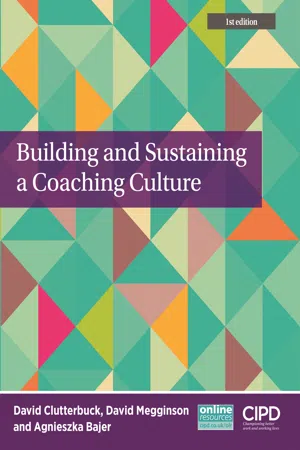
Building and Sustaining a Coaching Culture
- 240 pages
- English
- ePUB (mobile friendly)
- Available on iOS & Android
Building and Sustaining a Coaching Culture
About this book
Building and Sustaining a Coaching Culture is the ideal book for everyone who is passionate about coaching and who has an interest in creating an environment that supports learning and growth. Easy to navigate and logically structured, topics include the current understanding of coaching culture in organisations, coaching and mentoring culture strategy, making effective use of external coaches, formal and informal mentoring, developing and supporting internal coaches and mentors, team coaching, cross-cultural marketing coaching and cross-cultural issues. This edition of Building and Sustaining a Coaching Culture is a fully revised version of the seminal book Making Coaching Work: Creating a Coaching Culture. It analyses what has changed in the field of coaching culture and provides update on new knowledge and experience. A wide variety of international case studies and engaging tools such as chapter overviews, templates, and reflective questions will take you clearly through the development and implementation of a successful and integrated training culture. Whether you are an HR Manager looking to maximise the positive impact of coaching in your organisation, a business leader wanting to facilitate growth, or a consultant or coach seeking to place your work in the relevant organisational context, you will be shown how to implement an effective coaching and mentoring strategy that meets your needs.
Frequently asked questions
- Essential is ideal for learners and professionals who enjoy exploring a wide range of subjects. Access the Essential Library with 800,000+ trusted titles and best-sellers across business, personal growth, and the humanities. Includes unlimited reading time and Standard Read Aloud voice.
- Complete: Perfect for advanced learners and researchers needing full, unrestricted access. Unlock 1.4M+ books across hundreds of subjects, including academic and specialized titles. The Complete Plan also includes advanced features like Premium Read Aloud and Research Assistant.
Please note we cannot support devices running on iOS 13 and Android 7 or earlier. Learn more about using the app.
Information
PART ONE
THE ABCS OF COACHING CULTURE PLANNING AND IMPLEMENTATION
CHAPTER 1
So, What is a Coaching Culture After All?
WHAT IS CULTURE AND WHY BOTHER?
- culture exists, and
- there are valid reasons we should bother.
- decision-making processes and criteria (how decisions are made and what is considered to be the ‘right decisions’ for the organisation)
- what is deemed to be appropriate behaviour and acceptable ways of interacting with others
- how people perceive their responsibilities and deal with tasks that are assigned to them
- the promptness and efficiency with which the organisation performs its key functions
- an organisation’s agility and adaptability to change
- the way the organisation perceives and interacts with the main stakeholders outside of the organisation.
WHAT CULTURE LOOKS AND FEELS LIKE
DEFINING CULTURE
- Ouchi (1981) Theory Z: How American Business Can Meet the Japanese Challenge.
- Pascale and Athos (1981) The Art of Japanese Management: Applications for American Executives.
- Deal and Kennedy (1981) Corporate Cultures: The Rites and Rituals of Corporate Life.
- Peters and Waterman (1982) In Search of Excellence: Lessons from America’s Best Run Companies.
- Culture is created over time through the interaction of people and their environment. This is clearly expressed by Schein when he portrays culture as “a pattern of basic assumptions – invented, discovered, or developed by a given group as it learns to cope with its problems of external adaptation and internal integration – that has worked well enough to be considered valid and, therefore, to be taught to new members as the correct way to perceive, think, and feel in relation to those problems” (Schein 1992).
- Culture creates consistent patterns of meaning and behaviour that bind people together and make them unique as a group. This idea has been expressed by Hofstede (1980), Martin and Siehl (1992), Schein (1992), Van den Berg and Wilderom (2004), Wagner and Hollenbeck (2010) and many others.
- Culture is a combination of visible and invisible elements that exist on multiple levels. Arguments supporting this can be found in the work of a number of academics, for example, Martin and Siehl (1983), Uttal (1983), Denison (1990).
Table of contents
- Cover
- Title
- List of figures, tables and exhibits
- About the authors
- Preface
- Acknowledgements
- About the book
- Part 1 A Fresh View On Coaching Culture
- Part 2 The Abcs Of Coaching Culture Planning And Implementation
- Part 3 Laying The Foundations
- Part 4 Moving Beyond The Basics
- Epilogue
- Resources and Bibliography
- Index